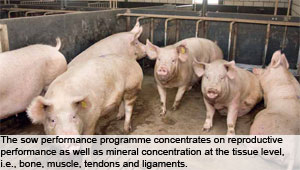Improving sow performance: Focus on the total picture

Culling rates and poor sow performance are serious concerns for the pork industry around the globe. Until recently, the opportunity to reverse performance-related trends seemed grim. However, results of a recent three-year study have led to the development of a programme offering pork producers new avenues for combating this costly problem.
By Lori Weaver
With producers already having cut expenditures throughout their operation in the face of shriveling profits, making strides to improve sow performance and longevity could be the best opportunity for a more profitable future. More on the theme of sow longevity could also be read on page 6.
Significant impact
Realising the significant impact that sow performance and longevity have on pork production, Novus International created the (Equalizing) Sow Performance (SP) programme for pork producers to evaluate ways to improve sow performance. The animal nutrition company has worked to develop a programme addressing a number of risks affecting optimal sow performance. The SP programme concentrates on reproductive performance as well as mineral concentration at the tissue level, i.e., bone, muscle, tendons and ligaments.
The programme was developed to optimise sow health, overcome common performance-inhibiting factors and balance seasonal peaks and valleys commonly seen in sow performance, see Figure 1. Because the SP programme is looking at total sow performance and not just one aspect of herd management, it is designed to lessen a number of stress factors and their associated risks, including:
- heat and humidity;
- disease and pathogen challenges;
- ration and ingredient changes;
- breeding and conception rates;
- farrowing and piglet livability;
- feed intake during lactation;
- laminitis and structural integrity; and
- weaning.
Dr Felipe Navarro, DVM and global market manager for pork, Novus International, points out that by lessening the impact these stress factors have on the sow herd, sows are able to perform at levels that meet or exceed performance expectations.
At the core of the SP programme is a three-year study which involved more than 12,000 sows at its start. Navarro believes what Novus has learned suggests the study should continue and that the SP programme will have significant impact in all swine markets.
Duplicating commercial conditions
In designing the programme, the company’s objective was to slow profit erosion and shift culling from a reproductive and mobility issue to a true ‘old age’ one. The company focused on what impact supplemental chelated trace minerals could provide in reversing what has been a difficult trend to overcome worldwide. The study first got under way in 2005 and utilised two commercial farm settings, both under the same production management, in order to mirror real-world conditions. Duplicating on-farm practices was extended to the sow diets at both locations with pigs provided with rations containing 20% DDGs during gestation and 30% DDGs while in lactation.
Each farm housed 6,400 sows divided into just two groups: a control receiving inorganic trace mineral supplementation and a second group that was provided with a chelated mineral supplement (Mintrex, Novus International). The chelated mineral supplement contained zinc, copper and manganese and replaced the control mineral supplement by 50%, leaving both treatments with the same total mineral amounts, but in differing forms.The National Research Council recommends mineral supplementation and believes that trace minerals – such as copper, manganese and zinc – have naturally low bioavailabilities from feed and are not readily available for absorption in the animal gut. Inorganic mineral salts traditionally used in animal diets tend to fall prey to physical and chemical degradation due to dietary and environmental antagonisms found in the digestive tract. This impaired absorption results in only a small amount of the needed inorganic mineral making it to the animals’ intestinal absorption sites. Unfortunately, much of the inorganic mineral is excreted, not only lost to the animal but posing a potential environmental threat as well.Chelated trace minerals, on the other hand, are chemically bound to a compound – an organic ligand – that helps to improve the bioavailability of the mineral. This type of bonding creates a stable complex in the upper gastrointestinal tract. This stability can reduce losses due to factors affecting absorption, allowing efficient utilisation by the animal.The most effective trace minerals are those which are stable even at low ranges of pH. This means that not all minerals are created equal where animal diets are concerned.
Dietary mineral levels for both groups in the Novus study were 16.55 ppm copper, 165 ppm zinc and 38.6 ppm manganese. “The primary phase of the study lasted from 1 April 2007 to 1 April 2010. Within the study to date, a total of 16,000 sows up to parity 7 are providing 40,000 sow data points,” says Navarro.“Sows that were supplemented with the chelated mineral mixture had more total piglets born, a lowered overall removal rate and lower removal rate for locomotion. They also exhibited better mycoplasma antibody titres response, a better mobility score and heavier piglets at birth,” notes Navarro.
Optimal data collection
Studies as extensive as the one under taken on sow performance – spanning over three years to-date and involving 16,000 sows with over 40,000 sow data points across two commercial farms – can be difficult to implement due to the need for a commercial setting, the large number of animals required, the continued optimal data collection over extended time periods and the need for data to be properly analysed. Novus plans to make its resulting SP programme available globally.
“Overall sow performance is very critical to pork production systems due to its impact on economic outcome and animal well-being considerations,” Navarro sums up. “A decreased removal rate of sows – as we are seeing with diligent incorporation of the SP programme – reduces the costs for replacement gilts and increases net income at a time when the pig production industry is operating on very slim profit margins.”











